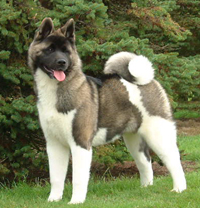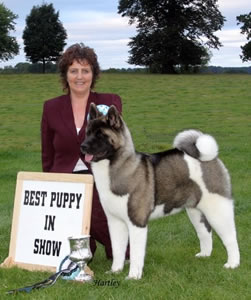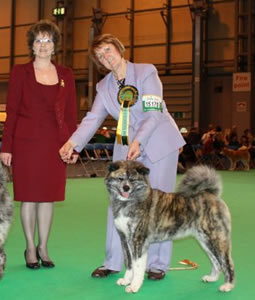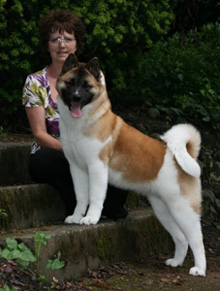 In Japan and Europe events in recent years have created a situation where confusion over breed names, types, and judging has arisen. In Japan and Europe events in recent years have created a situation where confusion over breed names, types, and judging has arisen.
This is particularly evident where judges officiate in both F.C.I countries and in the UK.
I aim to clarify different aspects of the breed by giving a brief, but in no way complete history of the breed.
There is no doubt that dogs of the Akita type are an ancient breed and the original dogs of the spitz type in Japan were small to medium size and no large dogs of this type existed.
Illustrations from 1st millennia AD onwards depict solid coloured hunting dogs leading hunters and Samurai equipped with bows and arrows.
In the Akita region of Japan during this period, hunter gathering became a way of life and later some villages made their living, and became dependent upon hunting, particularly with dogs; these villages were called Matagi villages.
Dogs from these villages were referred to as Matagi Inu – simply translated as “hunting dog”. They were a type of spitz breed that were chosen for their ability to hunt, but of no particular standardised type.
 From the early 1600s in the Akita region of Japan these medium sized hunting dogs, were also used as fighting dogs, and were often referred to as Akita Matagis. From the early 1600s in the Akita region of Japan these medium sized hunting dogs, were also used as fighting dogs, and were often referred to as Akita Matagis.
The name Akita is derived from the region of Japan where these dogs were believed to originate, particularly a region called Odate.
Mid to late 1800s Akita Matagis were crossed with other indigenous Japanese breeds, dogs of the mastiff type, and other foreign dogs in order to increase their size for fighting purposes.
Increasing the size of this breed was effective but most of the spitz characteristics of the Matagi Inu were lost. Dog fighting was prohibited in Japan in the early 1900s. These larger dogs were preserved and improved by breeders as a large Japanese breed, an Akita.
As a result nine of what were considered superior examples of this breed were designated as natural monuments and the Japanese Akita, of the American type as we know it today came into being.
During the Japanese / American conflict in world war two, Japan was cut off by the American fleet and it was common to use dogs as a source of food and fur. The government ruled that all dogs be confiscated and destroyed for this purpose. Only military German Shepherds were exempt from regulations. Some fanciers attempted to circumvent this regulation by cross breeding their dogs with German Shepherds. Some hid dogs on farms and in the mountains, even giving dogs German Shepherd dog names to avoid the regulations.
By 1946 all dogs including Akita’s were in decline and the Akita existed in three different types.
- Matagi Akitas (the original hunting dog)
- Fighting Akitas (Matagi Akitas x Mastiff, influence)
- Shepherd Akitas (crossing of Akitas & shepherds)
Although this created a very confusing situation in the breed, after the Second World War Kongo Go, a dog from the Dewa breeding line, which exhibited characteristics of the Mastiff and GSD influence, became tremendously popular in Japan, as did his progeny.
 Many of the ‘Kongo Go’ type were taken back to America by the occupation forces and their offspring exported all over the world – the breed we now know in the UK as the Akita. Many of the ‘Kongo Go’ type were taken back to America by the occupation forces and their offspring exported all over the world – the breed we now know in the UK as the Akita.
Some Japanese fanciers did not approve of this type as a proper Japanese Breed. They set out to purify the strain back to the original Matagi Inu type that existed before cross breeding for fighting took place. Selective breeding. Of d
ifferent breeding stock; mainly dogs from the Ichinoseke breeding line and the Dewa breeding line, that produced Kongo Go were selected to achieve this type. Use of the Ichinoseke line and southern-bred dogs produced a better type, which exhibited more traits of the Matagi Inu, whilst the Kongo Go line went into decline in Japan because of its Mastiff/Shepherd influence.
It took about 35 years of concerted effort by breeders to restore the breed by breeding dogs that they considered carried the strongest bloodline of the Matagi Inu.
This breeding program began to produce red/sesame dogs with Urajiro markings, which eventually became highly admired and very popular.
Because of the popularity of these markings more breeders started to produce this type. This has resulted in re-establishing a purer strain of Akitas, as it existed before the advent of fighting dogs.
It is important to note that the resulting purification of the breed produced dogs that were still larger in size, and to some extent exhibiting many different traits than the original Matagi Hunting dog.
Some Akitas were imported into the UK in the 1930s. A dog of this type was exhibited at Crufts in 1936. They became popular in the mid to late 1980s with the majority of imports being of the American type.
Some kennels imported pure Japanese dogs at this time, and both types were placed on the same K.C register as ‘Akitas’. This meant that they were shown in the same classes and were able to be bred together and registered as the same breed. I do not believe that any of the original UK importers of pure Japanese stock did not at some stage cross breed the two types.
This would have a great impact for them during the year 2006 which I will elaborate upon later.
Outside of Japan a considerable amount of cross breeding was still taking place. During 1999 the F.C.I. announced that the breed was to be split into two separate breeds namely that the Japanese Type would be referred to as “Akitas” and the American type as “American Akitas”.
During 2001 the J.K.C. ruled that no stock would be sold or exported to countries that had not split the breed, in an attempt to prevent cross breeding. These countries include Canada, U.S.A. and the U.K. The F.C.I. countries split the breed on the premise of Phenotype, that is if it looked like a Japanese Akita as set down in the JKC standard, then it was registered as an Akita. If it looked like an American Akita then it was registered as an American Akita.
In 2004 the Kennel Club announced that they would split the breed on 1st January 2006. All fanciers thought that the breed would be split along the same phenotype criteria as the F.C.I. Countries - they were wrong!! The Kennel Club announced that the breed would be split on Genotype. Only dogs with proven three generations of pure Japanese lines were to be registered as Japanese Akita Inu.
All the others including those that looked like the Japanese, type but did not fit the genetic criteria would stay on the Akita registry.
There is some thinking that perhaps this was the wrong way to go, and there are pros and cons for both arguments. Even so the genotype split in the UK meant that we have the purist bred Akita Inu anywhere in the World outside of Japan.
 In the UK, American type Akitas are called ‘Akitas’ and Japanese type are called “Japanese Akita Inu”. To confuse the matter American type Akitas in FCI countries are called “American Akitas” and the Japanese type are simply called “Akitas”. It is worthy to note that at the inception of the split in the F.C.I. countries the American Akita was originally designated as a “Great Japanese Dog”. This was eventually changed and the name “American Akita” came into being. In the UK, American type Akitas are called ‘Akitas’ and Japanese type are called “Japanese Akita Inu”. To confuse the matter American type Akitas in FCI countries are called “American Akitas” and the Japanese type are simply called “Akitas”. It is worthy to note that at the inception of the split in the F.C.I. countries the American Akita was originally designated as a “Great Japanese Dog”. This was eventually changed and the name “American Akita” came into being.
In the UK the breed is still in its infancy. 2006/2007 saw some Championship Show Societies schedule classes for the breed and some specimens did achieve high honours in Group Placements and AVNSC.
The newly formed Japanese Akita Inu Club was born out of an amalgamation of the two previously proposed breed clubs.
Application for registration of title for this new club was given K.C. approval in January 2007 and became the first recognised breed club.
At Crufts 2007 we saw the first classes scheduled for the breed. |

